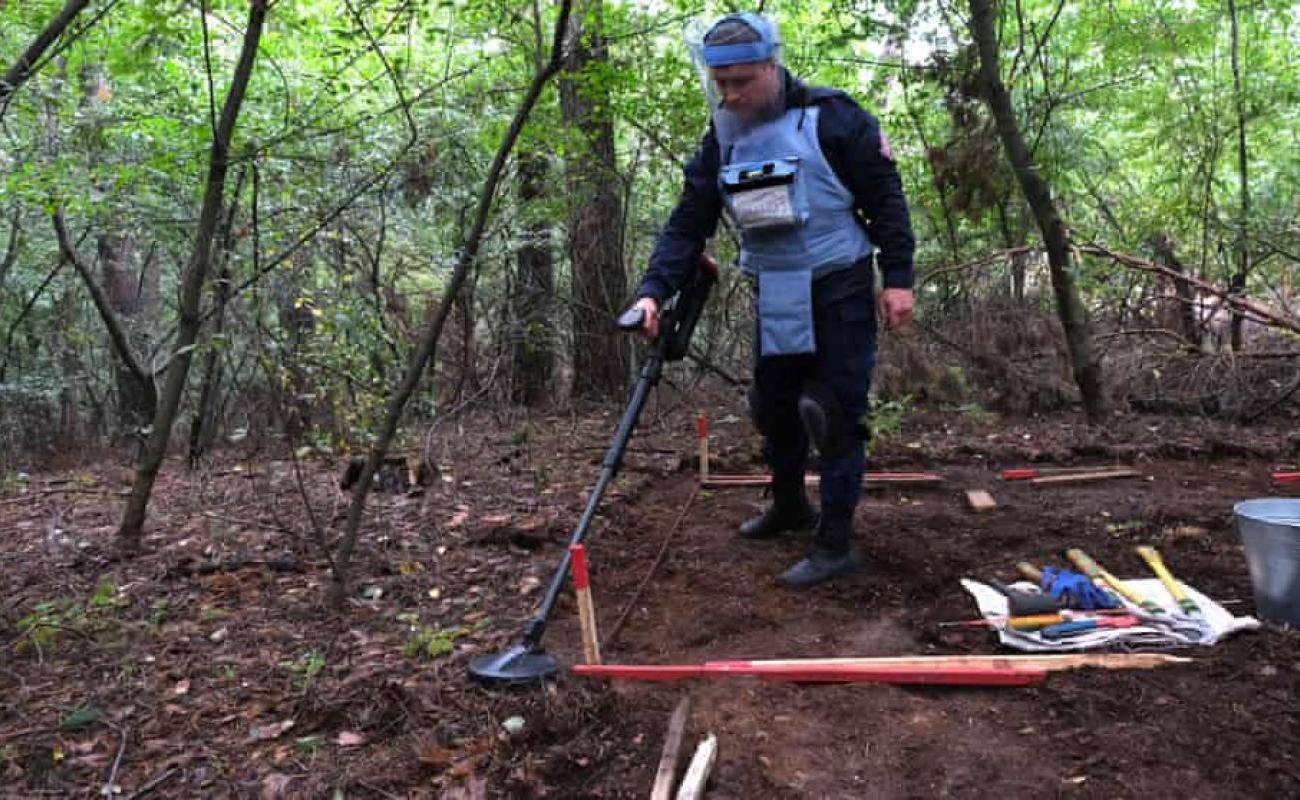Danger in every step: the ‘chaotic and complex’ work of Ukraine’s de-miners

In the forest bordering the village of Zalissia, north-east of Ukraine’s capital, Kyiv, a yellow painted wooden stake has been driven in the sandy ground next to a tree trunk shredded by a mine.
A local man, Eduard, came into the forest to look for items looted from his home by Russian soldiers during their occupation of Zalissia early in the war amid the Kremlin’s failed offensive against Kyiv when this forest was the front ine. He triggered an OZM “bounding” anti-personnel mine rigged to tripwire and was killed in the blast.
While Russian trenches and foxholes are still visible among trees, these days the forest is busy with de-mining teams working with the British Halo Trust, a mine-clearing charity.
Further incidents in late September underlined the risk: an ambulance ran over a mine near Balakliya, and four people walking in a forest near Chernihiv died after tripping a mine.
Even before Russia’s full-scale invasion earlier this year, de-miners were confronting a years-long effort to clear mines from Ukraine’s east. The country was ranked fifth in the world for civilian casualties caused by mines and in the top three for anti-vehicle mine incidents.
Local de-mining experts are warning that even if the war were to end tomorrow, it will take at least a decade to clear the threat.
While efforts by the Ukrainian state emergency services, the military and local and international NGOs have been highly sophisticated, footage shared on social media has also shown riskier approaches, including video of soldiers triggering mines with branches and even thrown tyres.
With heavy fighting continuing in the south and east of the country, de-miners are seeing more and different kinds of mines deployed by Russian forces, including butterfly mines, dubbed “petals” by the Ukrainians: small plastic anti-personnel mines that have become notorious around the globe for their ability to inflict casualties long after wars have ended.
In the village of Zalissia, on the main road between Chernihiv and Kyiv, the presence of mines in the forest has social, psychological and economic consequences – and poses an immediate risk.
Before the Russian invasion, this road was known in autumn for the elderly residents who would sell berries and mushrooms they collected in the forest to passing motorists to supplement their meagre pensions, while families would walk and picnic among the trees.
Iryna Horyushko, a mine clearance senior supervisor, shared a map dotted with areas to be surveyed and clear, a slow and laborious manual process because the heavy tree cover makes it difficult to deploy the mechanical mine-clearing machines that are used on the steppe to the south.
“We started working here in July. As you can see, 97% of this area is forest with pine trees and scrub. The effort is complicated because we are so close to the highway. Every morning local people come to the bus stop and we still have forestry workers coming into the forest, so we have to stop work if anyone comes close.
“Because of the Russian occupation, there are a lot of trenches and lot of metal signals [on the mine detectors]. Because of the threat type, it is very time-consuming and meticulous. De-miners need to be on their knees all day to clear 8-16 sq metres a day.”
Along a cleared path among the trees, Iryna paused to point out a tripwire – a fine filament almost invisible amid the leaf meal – whose end they have yet to reach.
The mine clearer whose job is to follow the tripwire uses a handheld wand to check the area ahead of where he is working to head height looking for more tripwires before dropping to his knees to search the ground in front of him.
“People can’t go back to their normal lives,” said Tymur Pistriuha of the Ukrainian De-miners’ Association, a nonprofit group that represents de-mining companies in the country.
“I have a friend who won’t let her child see her father because he lives in a city that was recently liberated because she is afraid of the risk. This should be the season when people pick mushrooms and berries, and collect firewood across Ukraine, but they have been warned not to go into the forest by the government.”
